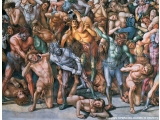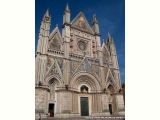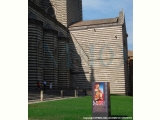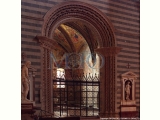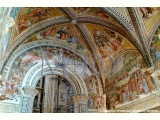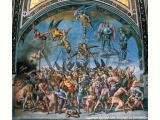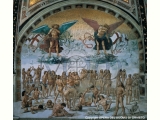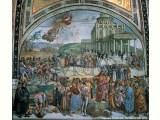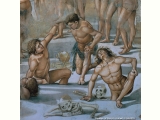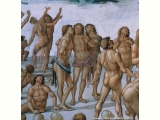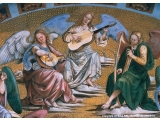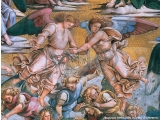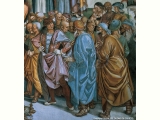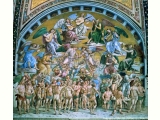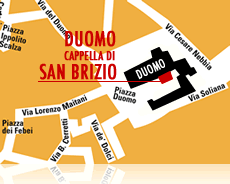Siete qui:
- Home
- The MODO Museum
- The Museums Venues
- Cathedral â Chapel of S. Brizio
Cathedral â Chapel of S. Brizio
The highlight of the visit to the MODO itinerary is the chapel of San Brizio or Cappella Nova. With its "figurative opulence" (J. Riess) this chapel, at the end of the south arm of the transept in the Cathedral of Orvieto, differs profoundly in its concept of space and decoration from the sober bare interior of the Cathedral in its present state. It is an outstanding example of Italian Renaissance painting.
This new architectural element – a chapel in honor of Our Lady of the Assumption, known as Cappella Nova – was added to the transept in the right aisle of the Cathedral between 1406 and 1444. It also came to be known as Chapel of the Madonna of San Brizio when the venerable icon of the Madonna of San Brizio was moved there in 1622. It is still there on the main altar – a panel in Byzantine style, an enigma as to dating and attribution, with the Virgin enthroned and the Child depicted on a gold ground, flanked by Angels and with the face of Christ above. The chapel was built against the south side of the transept, on the site of a small chapel dedicated to the Magi and the "old sacristy". The side walls incorporated the buttresses previously erected when Lorenzo Maitani came to Orvieto as capomastro or master builder of the Cathedral, and acts as companion piece to the Chapel of the Holy Corporal.
Even though literary sources on the Cathedral disagree as to who financed the undertaking (the Roman Curia, the Medici or the local lords), the Monaldeschi family was unquestionably involved (as testified by the coats of arms in the corners of the vault section with the Virgins) with bequests disbursed in 1462, 1494 and 1498. The decoration of the Chapel was however carefully controlled and paid for with its own funds by the Opera del Duomo, to which the coat of arms of the Fabbrica on the entrance arch bears witness.
Initially the Opera del Duomo entrusted the Dominican friar Giovanni da Fiesole (395-1455), known as Fra Angelico, with the decoration of the vaults and walls. Fra Angelico was already famous as artist for the papal court. The contract was stipulated in June of 1447 and the painter was to be present in the Orvieto workshop during the summer months until the pictorial cycle was completed. The young Benozzo Gozzoli (1421-1497), who was later to execute the frescoes in the Church of San Francesco in Montefalco, was one of Fra Angelico's assistants.
The angelicus pictor began work on the cross vault above the altar where he painted Christ the Judge, seated on his throne as Pantocrator or Ruler of the World and surrounded by hosts of Cherubim, Seraphim, Thrones and Angels. In the section on his left are the Prophets (PROPHETARUM LAUDABILIS NUMERUS). The decoration of the ribs with floral and plant motifs and the frames of the portions with portraits inside medallions are also to be attributed to Angelico's workshop.
At the end of the summer of 1447, as planned, the artist suspended his work and returned to the Vatican. Actually he never returned to Orvieto, leaving this great undertaking unfinished. After various vain attempts and lengthy negotiations with the most famous painters of the time, including Perugino, the work begun by Fra Angelico was continued and finished fifty years later by Luca Signorelli (1445.-1523). This painter from Cortona, identified in the documents as "famosissimus pictor in tota Italia" (extremely famous painter in all Italy) was engaged in 1499 to complete the decoration of the vaults on the basis of Fra Angelico's designs.
Beginning with the inner bay, and in line with his predecessor's project, he painted the section to the right of Christ the Judge with the figures of the Apostles and the Virgin (GLORIOSUS APOSTOLORUM CHORUS) and the section opposite with the figures of angels bearing the Symbols of the Passion (SIGNA IUDICIUM INDICANTIA). In the vault segment towards the entrance he depicted the Doctors of the Church (DOCTOR SAPIENS ORDO), the Martyrs (MARTYRUM CANDIDATUS EXERCITUS), the Patriarchs (NOBILIS PATRIARCHARUM COETUS) and the Choir of Virgins (CASTARUM VIRGINUM COHORS), identifiable in this sequence beginning on the right.
In a second contract, stipulated on April 27, 1500, Signorelli and his many assistants were committed to frescoing the walls of the chapel. In the next three years the scenes of the Last Judgement took shape in the large lunettes, with the serried and imaginative decoration of grotesques, surrounding panels of "illustrious men" and scenes from their works, in the lower register. In the base tritons and nereids were painted in fictive relief to resemble panels on classic sarcophagi.
The Chapel as it is now is the result of a series of transformations that include renovation, maintenance, restoration, up to the final restoration of 1989-96, which involved the masonry structures and above all the pictorial cycle. These restorations were aimed at improving the climatic-environmental conditions of the Chapel and of reviving the original hues, as well as bringing to light previously unknown parts of the frescoes behind the altar and inside a cavity wall in the western wall.



